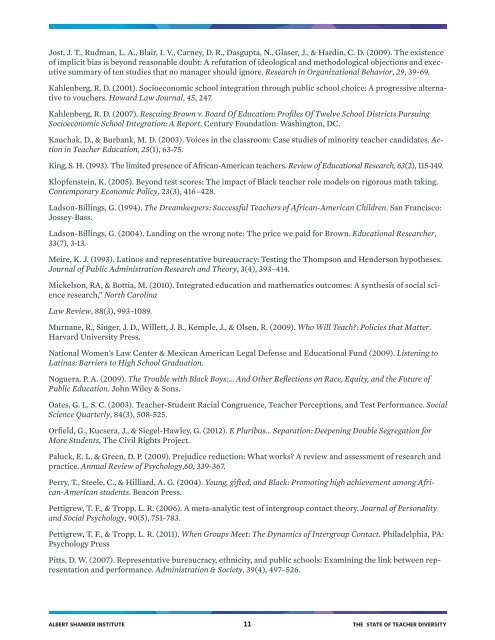TEACHER DIVERSITY
The State of Teacher Diversity_0
The State of Teacher Diversity_0
- No tags were found...
Create successful ePaper yourself
Turn your PDF publications into a flip-book with our unique Google optimized e-Paper software.
Jost, J. T., Rudman, L. A., Blair, I. V., Carney, D. R., Dasgupta, N., Glaser, J., & Hardin, C. D. (2009). The existence<br />
of implicit bias is beyond reasonable doubt: A refutation of ideological and methodological objections and executive<br />
summary of ten studies that no manager should ignore. Research in Organizational Behavior, 29, 39-69.<br />
Kahlenberg, R. D. (2001). Socioeconomic school integration through public school choice: A progressive alternative<br />
to vouchers. Howard Law Journal, 45, 247.<br />
Kahlenberg, R. D. (2007). Rescuing Brown v. Board Of Education: Profiles Of Twelve School Districts Pursuing<br />
Socioeconomic School Integration: A Report. Century Foundation: Washington, DC.<br />
Kauchak, D., & Burbank, M. D. (2003). Voices in the classroom: Case studies of minority teacher candidates. Action<br />
in Teacher Education, 25(1), 63-75.<br />
King, S. H. (1993). The limited presence of African-American teachers. Review of Educational Research, 63(2), 115-149.<br />
Klopfenstein, K. (2005). Beyond test scores: The impact of Black teacher role models on rigorous math taking.<br />
Contemporary Economic Policy, 23(3), 416–428.<br />
Ladson-Billings, G. (1994). The Dreamkeepers: Successful Teachers of African-American Children. San Francisco:<br />
Jossey-Bass.<br />
Ladson-Billings, G. (2004). Landing on the wrong note: The price we paid for Brown. Educational Researcher,<br />
33(7), 3-13.<br />
Meire, K. J. (1993). Latinos and representative bureaucracy: Testing the Thompson and Henderson hypotheses.<br />
Journal of Public Administration Research and Theory, 3(4), 393–414.<br />
Mickelson, RA, & Bottia, M. (2010). Integrated education and mathematics outcomes: A synthesis of social science<br />
research,” North Carolina<br />
Law Review, 88(3), 993–1089.<br />
Murnane, R., Singer, J. D., Willett, J. B., Kemple, J., & Olsen, R. (2009). Who Will Teach?: Policies that Matter.<br />
Harvard University Press.<br />
National Women’s Law Center & Mexican American Legal Defense and Educational Fund (2009). Listening to<br />
Latinas: Barriers to High School Graduation.<br />
Noguera, P. A. (2009). The Trouble with Black Boys:... And Other Reflections on Race, Equity, and the Future of<br />
Public Education. John Wiley & Sons.<br />
Oates, G. L. S. C. (2003). Teacher-Student Racial Congruence, Teacher Perceptions, and Test Performance. Social<br />
Science Quarterly, 84(3), 508-525.<br />
Orfield, G., Kucsera, J., & Siegel-Hawley, G. (2012). E Pluribus... Separation: Deepening Double Segregation for<br />
More Students, The Civil Rights Project.<br />
Paluck, E. L. & Green, D. P. (2009). Prejudice reduction: What works? A review and assessment of research and<br />
practice. Annual Review of Psychology,60, 339-367.<br />
Perry, T., Steele, C., & Hilliard, A. G. (2004). Young, gifted, and Black: Promoting high achievement among African-American<br />
students. Beacon Press.<br />
Pettigrew, T. F., & Tropp, L. R. (2006). A meta-analytic test of intergroup contact theory. Journal of Personality<br />
and Social Psychology, 90(5), 751–783.<br />
Pettigrew, T. F., & Tropp, L. R. (2011). When Groups Meet: The Dynamics of Intergroup Contact. Philadelphia, PA:<br />
Psychology Press<br />
Pitts, D. W. (2007). Representative bureaucracy, ethnicity, and public schools: Examining the link between representation<br />
and performance. Administration & Society, 39(4), 497–526.<br />
ALBERT SHANKER INSTITUTE 11 THE STATE OF <strong>TEACHER</strong> <strong>DIVERSITY</strong>


